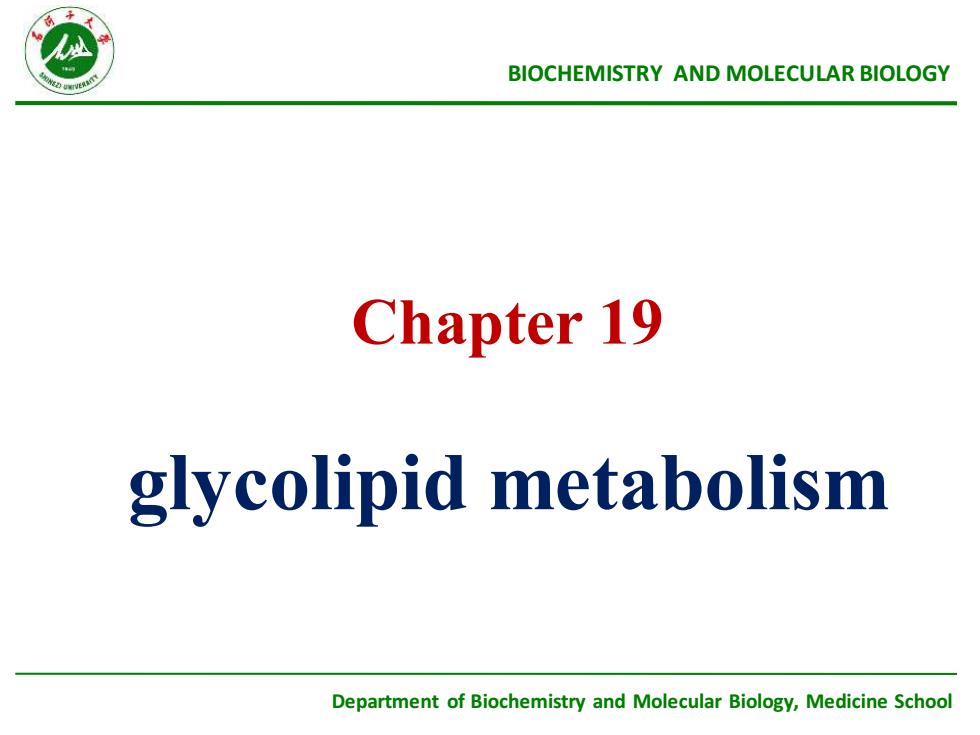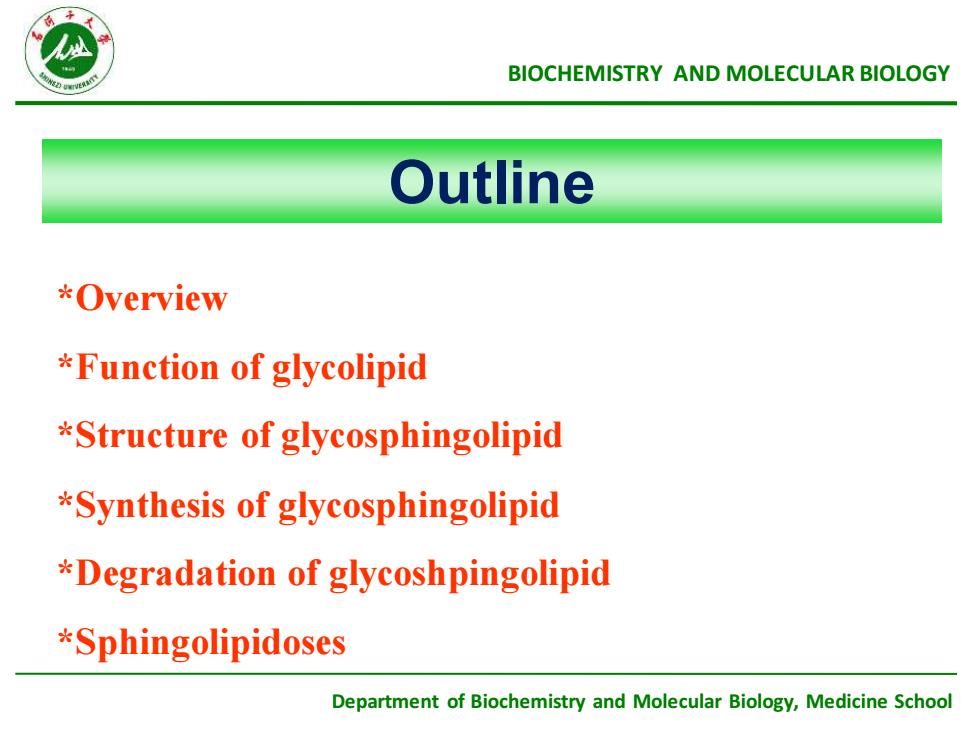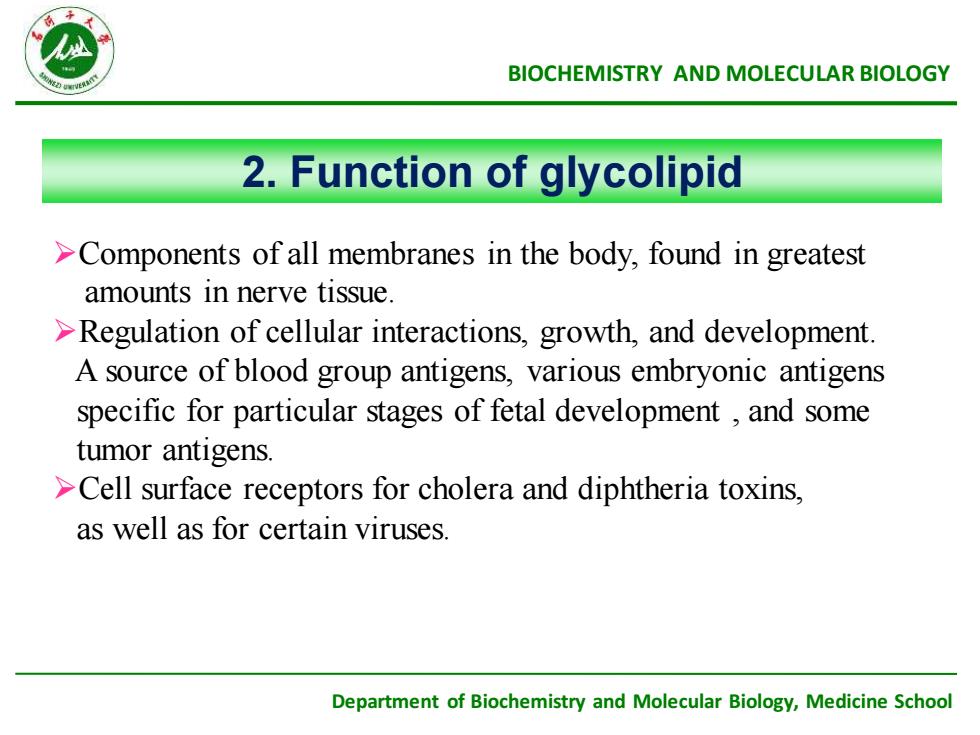
BIOCHEMISTRYANDMOLECULARBIOLOGYChapter 19glycolipid metabolismDepartment of Biochemistry and Molecular Biology,Medicine School
Department of Biochemistry and Molecular Biology, Medicine School BIOCHEMISTRY AND MOLECULAR BIOLOGY Chapter 19 glycolipid metabolism

BIOCHEMISTRYANDMOLECULARBIOLOGYOutline*Overview*Function of glycolipid*Structure ofglycosphingolipid*Synthesis of glycosphingolipid*Degradation ofglycoshpingolipid*SphingolipidosesDepartment of Biochemistry and Molecular Biology,Medicine School
Department of Biochemistry and Molecular Biology, Medicine School BIOCHEMISTRY AND MOLECULAR BIOLOGY Outline *Overview *Function of glycolipid *Structure of glycosphingolipid *Synthesis of glycosphingolipid *Degradation of glycoshpingolipid *Sphingolipidoses

BIOCHEMISTRYANDMOLECULARBIOLOGY1.overviewLike the phospholipid sphingomyelin, almost allglycolipids are derivatives of ceramides in which amolecule of fatty acid is attached to the aminoalcohol.sphingosine. They are therefore more precisely calledglycosphingolipidsDepartment of Biochemistry and Molecular Biology,Medicine School
Department of Biochemistry and Molecular Biology, Medicine School BIOCHEMISTRY AND MOLECULAR BIOLOGY Like the phospholipid sphingomyelin, almost all glycolipids are derivatives of ceramides in which a molecule of fatty acid is attached to the aminoalcohol, sphingosine. They are therefore more precisely called glycosphingolipids. 1. overview

BIOCHEMISTRYANDMOLECULARBIOLOGY2.Functionofglycolipid>Components of all membranes in the body, found in greatestamounts in nerve tissue>Regulation of cellular interactions, growth, and developmentA source of blood group antigens, various embryonic antigensspecific for particular stages of fetal development , and sometumor antigens>Cell surface receptors for cholera and diphtheria toxinsas well as for certain viruses.Department of Biochemistry and Molecular Biology,Medicine School
Department of Biochemistry and Molecular Biology, Medicine School BIOCHEMISTRY AND MOLECULAR BIOLOGY ➢Components of all membranes in the body, found in greatest amounts in nerve tissue. ➢Regulation of cellular interactions, growth, and development. A source of blood group antigens, various embryonic antigens specific for particular stages of fetal development , and some tumor antigens. ➢Cell surface receptors for cholera and diphtheria toxins, as well as for certain viruses. 2. Function of glycolipid

BIOCHEMISTRYANDMOLECULARBIOLOGY2.Functionof glycolipidWhen cell lose control of cell division and growth, there is adramatic change in the glycosphingolipid composition of themembrane.>Genetic disorders associated with an inability to properlydegrade the glycosphingolipids can result in inrtacellularaccumulation of these compounds leading to serious impairmentof the nervous system and development.Department of Biochemistry and Molecular Biology,Medicine School
Department of Biochemistry and Molecular Biology, Medicine School BIOCHEMISTRY AND MOLECULAR BIOLOGY ➢When cell lose control of cell division and growth, there is a dramatic change in the glycosphingolipid composition of the membrane. ➢Genetic disorders associated with an inability to properly degrade the glycosphingolipids can result in inrtacellular accumulation of these compounds leading to serious impairment of the nervous system and development. 2. Function of glycolipid